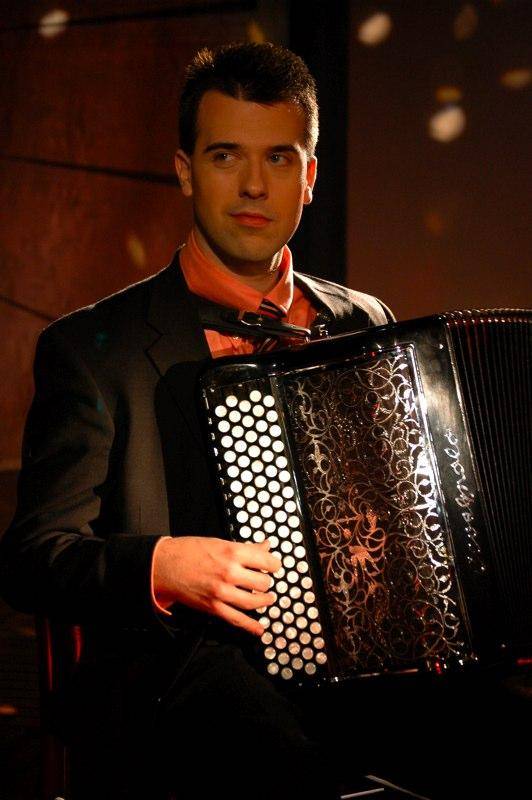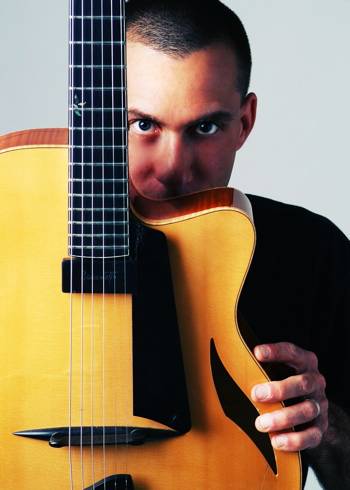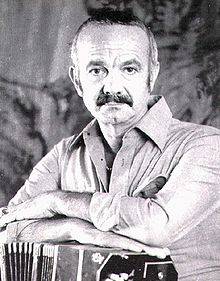 Okay, yes, if you want to get technical about it, The Ellnora Guitar Festival at the Krannert Center is a guitar festival. Sez so right there in the title. But apart from the stunning guitarists and the elbowing-room-only crowds in the lobby, one of the most noticeable features of the first evening’s performances was a welcome but easily overlooked event in musical history: the return of the accordion.
Okay, yes, if you want to get technical about it, The Ellnora Guitar Festival at the Krannert Center is a guitar festival. Sez so right there in the title. But apart from the stunning guitarists and the elbowing-room-only crowds in the lobby, one of the most noticeable features of the first evening’s performances was a welcome but easily overlooked event in musical history: the return of the accordion.
For Baby Boomers, the accordion was the epitome of old-fart music, the wheezy soundtrack of arthritic senior-center polkas. It also had some Old-European about it, and it’s noticeable that among the series of successful novels by Annie Proulx, her wonderful book Accordion Crimes, which chronicles the life journey of one instrument through a multitude of settings (most of them in the hands of recent immigrants), was the one flop.
Yet the accordion was a staple in American bands until remarkably recently, and not just for polkas. Bruce Macleod’s fine book Club Date Musicians examines the development of the all-purpose band playing club dates (weddings, anniversary arties, bar mitzvahs, debutante balls, high school proms) and explains that until well into the 1970s a four or five-piece band would invariably include a keyboard player, but not necessarily a pianist or organist, as we might suspect: in many places the house piano would be so bad that a dude who carried his own keyboard slung around his chest (an accordion player, in case I’m being too oblique, here) was virtually a necessity.
It was the guitar that nearly killed the accordion. Starting around 1975, every traveling band had to have an electric guitar player, even if he played only the few songs that the young’uns demanded, or else the whole ensemble would seem terminally square. And the cheap electronic keyboard replaced the accordion not because it was more expressive (definitely not) but because the accordion was harder to learn and just looked and sounded wrong. Old, that is.
Fast forward to the Krannert Center last night, and two of the four bands unashamedly featured accordions right up their in the mix, in their very identity. The Brooklyn-based band Chicha Libre, who play what might be called Latin/surf/psychedelic rockabilly dance band music, included the fine musician Joshua Camp playing, according to their website, “an antiquated accordion/organ hybrid manufactured by Hohner called the Electravox.” Yeah, that’s right: “antiquated” as a synonym for cool. The band’s appeal is that it not only remixes Amazonian idioms with Ventures-style lead lines, but in doing so it remixes old with new in a way that is unmistakably new. And if the accordion, chugging away right up front, adds a southwestern/border dance band sound that could have come straight from the 1930s or 1940s, so much the better.
 But the Frank Vignola Quartet threw us something possibly even older and even newer, and entirely remarkable: the swing accordion in the French musette tradition played with the virtuosity and punch of a rock instrument.
But the Frank Vignola Quartet threw us something possibly even older and even newer, and entirely remarkable: the swing accordion in the French musette tradition played with the virtuosity and punch of a rock instrument.
The player in question was Julien Labro, a disgustingly young guy who grew up in Marseille, has been winning international awards since 1996 and moved to the U.S. in 1998. Now almost a local — or at least a fellow Midwesterner, having studied (and won a truckful of awards) at Wayne State — he’s only been playing with Frank for a handful of gigs, but already he fits right in.
First of all (and here’s a lesson for you young musicians), when Frank hired him he immediately went out and found all the Frank Vignola Trio’s recordings and learned every song. Bam. So when he showed up, he was ready to play.
Second, he knows from the marrow of his bones the Django Reinhardt tradition that combined French music-hall songs of the 1890s, the new tangos arriving from Argentina around 1910 and the American jazz that started crossing the Atlantic into Europe in the early 1930s. Plus he plays like a demon. Not having a clue how to play the button version of the accordion, I watched him mesmerized: there seem far too many buttons to play, or even to make musical sense, so his fingers seemed to be dashing around at random. Every so often I have dreams in which I’m playing the guitar but the guitar turn s out not to have strings, or not to be a guitar at all, but somehow by running my fingers around over whatever I discover has taken the place of the fingerboard, I play these amazing Chicago blues solos I can’t play at all in waking life. That’s how he seemed to play, and the unfamiliarity of the instrument added something indefinable to the band: this wasn’t just the fine, fine Frank Vignola swing music we already know and love-it was a whole new ensemble sound, with new textures and new attack.
s out not to have strings, or not to be a guitar at all, but somehow by running my fingers around over whatever I discover has taken the place of the fingerboard, I play these amazing Chicago blues solos I can’t play at all in waking life. That’s how he seemed to play, and the unfamiliarity of the instrument added something indefinable to the band: this wasn’t just the fine, fine Frank Vignola swing music we already know and love-it was a whole new ensemble sound, with new textures and new attack.
Next, of course, we could talk about Astor Piazzola and the revival of the bandoneon, which was the product of unprotected sex between an accordion and an anaconda, but it’s only 6 a.m., I didn’t get to bed until after 1:30 thanks to the reception in the Eastland Suites, and now I feel the need to crash. The accordion will have to continue its revival without me.
 Tim Brookes is the author of: Guitar: An American Life and the forthcoming The Greatest Guitarist in the History of the World. He’s in town to act as emcee, interviewer and man-on-the-sidewalk for the Ellnora Guitar Festival at the Krannert Center. Check out his blog at www.timbrookesinc.com.
Tim Brookes is the author of: Guitar: An American Life and the forthcoming The Greatest Guitarist in the History of the World. He’s in town to act as emcee, interviewer and man-on-the-sidewalk for the Ellnora Guitar Festival at the Krannert Center. Check out his blog at www.timbrookesinc.com.








